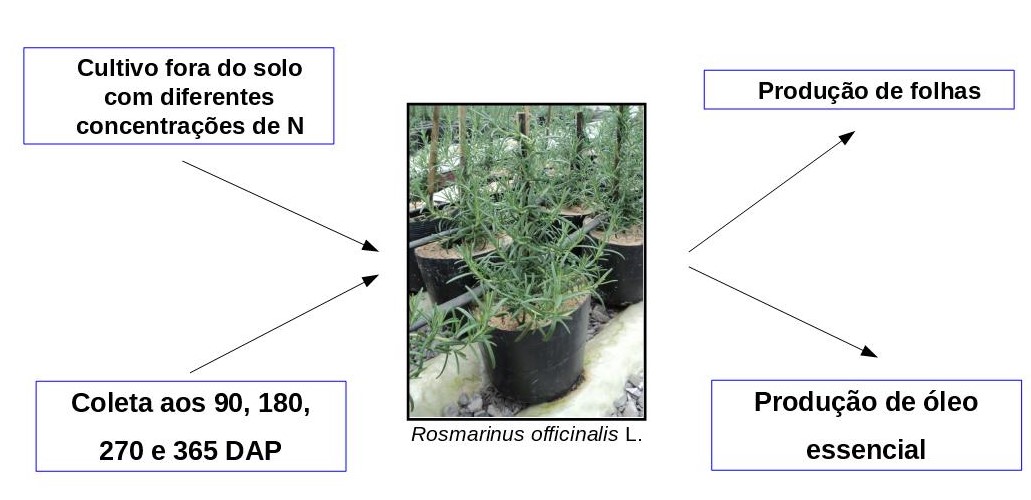Nitrogen influence and frequency of collections in the production of leaves and essential oil of rosemary (Rosmarinus officinalis)
DOI:
https://doi.org/10.70151/mg9zkb36Keywords:
Rosmarinus officinalis L., Dry mass, Fertirrigation, Aromatic plantsAbstract
The objective of this research was to determine the effect of nitrogen concentration and the periodicity of harvests on leaf growth and essential oil production of rosemary plants in soilless cultivation. Plants were grown in 3 dm3 polypropylene pots filled with sand and fertigated by means of nutrient solutions at N concentrations of 5.55; 8.05; 10.55; 13.05 and 15.55 mmol/l, without variations in concentrations of the other nutrients. The total number of harvests during the experimental period varied from one to four (C1, C2, C3 and C4). In C4, the first harvest was made in April 2013, at 90 (DAP), and repeated three times reaching four harvests at the end of the experiment; in C3, the first harvest was in July 2013, at 180 DAP, and repeated two times, reaching three harvests; in C2, the first harvest was in October 2013, at 270 DAP, and repeated once a time, reaching two harvests; in C1, only one harvest was made in January 2014, at 365 DAP, any harvest being done before. A 5x4 factorial entirely randomized experimental design was used, with 44 plants per plot. It was determined the leaf production and yield of essential oil extracted in a Clevenger. Results showed that leaf production and yield of essential oil are higher by making only one harvest at 365 DAP and using a nutrient solution at N concentration of 9.40 mmol/l.
Downloads
References
Aêgren GI, Franklin O (2003) Root: Shoot Ratios, Optimization and Nitrogen Productivity. Ann Bot. https://doi.org/10.1093/aob/mcg203
Amaral WI, Deschamps CI, Machado MPI, Koeler HSI, Scheer APII, Côcco LC (2014) Desenvolvimento da camomila, rendimento e qualidade do óleo essencial em diferentes idades de colheita. Rev Bras Pl Med. https://doi.org/10.1590/S1516-05722014000200011
Amaral W, Deschamps C, Favaretto N, Koeler HS, Sheer AP, Yamamoto C, Côcco CL (2008). Desenvolvimento, rendimento e composição de óleo essencial de camomila [Chamomila recutita (L.) Rauschert] sob adubação orgânica e mineral. Rev. Bras. Pl. Med. https://doi.org/10.1590/S1516-05722014000200011
Andriolo JL, Da Luz GL, Witter MH, Godoi RS, Barros GT, Bortolotto OC (2005). Growth and yield of lettuce plants under salinity. Hortic Bras. https://doi.org/10.1590/S0102-05362005000400014
Bergo CL, Mendonça HA, Silva MR (2005) Efeito da época e freqüência de corte de pimenta longa (Piper hispidinervum C. DC.) no rendimento de óleo essencial. Acta Amazon. https://doi.org/10.1590/S0044-59672005000200001
Bertolin TE, Centenaro A, Giacomelli B, Giacomelli F, Colla LM, Rodrigues VM (2010) Antioxidantes naturais na prevenção da oxidação lipídica em charque de carne ovina. Braziliam Journal of Food Tecnology. https://doi.org/10.4260/BJFT2010130200011
Berwick A (1998) Aromaterapia holística. Rio de Janeiro: Nova Era. 270p.
Castro HG, Ferreira FA, Mosquim PR (2004) Contribuição ao estudo das plantas medicinais: Metabólitos secundários. 2ª ed. Produção independente: Viçosa. 113p.
Costa AG, Ferraz EO, Deschamps C, Pinto JEBP (2010) Desenvolvimento vegetativo do patchouli após a aplicação de diferentes níveis de nitrogênio em plantio e rebrota. Hortic Bras. https://1library.org/document/yjjr1kpy-desenvolvimento-vegetativo-patchouli-aplicacao-diferentes-niveis-nitrogenio-plantio.html
Deschamps C, Monteiro R, Machado MP, Bizzo H, Biasi LA (2010) Produção de biomassa, teor e composição do óleo essencial de Mentha x piperitaL. em resposta a fontes e doses de nitrogênio. Rev Bras Pl Med. https://doi.org/10.1590/S1516-05722012000100003
Ferrari GN, Suguino E, Martins AN, Mello SC, Minami K (2011) Alecrim (Rosmarinus officinalis L.). Série Produtor Rural 49. Piracicaba: ESALQ- Divisão de Biblioteca. 33p.
Gayler S, Leser C, Priesack E, Treutter D (2004) Modelling the effect of environmental factors on the ‘trade-off’ between growth and defensive compounds in young apple trees. Trees-Struct Funct. https://doi.org/10.1007/s00468-003-0315-6
Glynn C, Herms DA, Orians CM, Hansen RC, Larsson S (2007)Testing the growth–differentiation balance hypothesis: dynamic responses of willows to nutrient availability. New Phytol. https://doi.org/10.1111/j.1469-8137.2007.02203.x
Iqbal N, Masood A, Khan NA (2012) Analyzing the significance of defoliation in growth, photosynthetic compensation and source-sink relations. Photosynthetica. https://doi.org/10.1007/s11099-012-0029-3
Le Bot J, Bénard C, Robin C, Bourgaud F, Adamowicz S (2009) The 'trade-off' between synthesis of primary and secondary compounds in young tomato leaves is altered by nitrate nutrition: experimental evidence and model consistency. J Exp Bot. https://doi.org/10.1093/jxb/erp271
Marques VB, De Paiva HN, Gomes JM, Neves JCL (2006) Efeitos de fontes e doses de nitrogênio no crescimento de mudas de sabiá (Mimosa caesalpiniaefolia Benth.). Scientia Forestalis. http://www.bibliotecaflorestal.ufv.br:80/handle/123456789/16927
Martinez HEP (2005) Hidroponia. Viçosa: Editora Aprenda Fácil. 271p.
MaY A, Suguino E, Martins AN, Pinheiro MQ (2010) Produção de biomassa e óleo essencial de Mentha citrata em função do manejo cultural e adubação nitrogenada. Rev Bras Ciênc Agrár. https://doi.org/10.5039/agraria.v5i3a809
May A, Suguino E, Martins AN, Barata LES, Pinheiro MQ (2010) Produção de biomassa e óleo essencial de alecrim (Rosmarinus officinalis L.) em função da altura e intervalo entre cortes. Rev Bras PlMed. https://doi.org/10.1590/S1516-05722010000200011
Pardossi A, Carmassi G, Diara C, Incrocci L, Maggini R, Massa D (2011) Fertigation and Substrate Management in Closed Soilless Culture. University of Pisa: Dipartimento di Biologia dele Piante Agrarie. 63p.
Schmidt , Santo OS, Bonnecarrère RAG, Mariani AO, Manfron PA (2001) Desempenho de soluções nutritivas e cultivares de alface em hidroponia. Hortic Bras. https://doi.org/10.1590/S0102-05362001000200005
Shannon MC, Grieve CM (1999) Tolerance of vegetable crops to salinity. SciHort. https://doi.org/10.1016/S0304-4238(98)00189-7
Sifola MI, Barbieri G (2006) Growth, yield, and essential oil contente of three cultivars of basil grow nunder different levels of nitrogen in the field. Sci Hort. https://doi.org/10.1016/j.scienta.2006.02.002
Silva F, Santos RHS, De Andrade NJ, Barbosa LCA, Casali VWD, De Lima RR, Passarinho RVM (2005) Basil conservation affected by cropping season, harvest time and storage period. Pesq Agropec Bras. https://doi.org/10.1590/S0100-204X2005000400002
Singh, M (2011) Influence of organic mulching and nitrogen application on essential oil yield and nitrogen use efficiency of rosemary (Rosmarinus officinalis L.). Arch Agron Soil Sci. https://doi.org/10.1080/03650340.2011.608157
Souza MAA, De Araujo OJL, Ferreira MA, Stark EMLM, Fernandes MS, Souza SR (2007) Produção de biomassa e óleo essencial de hortelã em hidroponia em função de nitrogênio fósforo. Hort Bras. https://doi.org/10.1590/S0102-05362007000100009

Downloads
Published
Issue
Section
License

This work is licensed under a Creative Commons Attribution-NonCommercial-NoDerivatives 4.0 International License.

